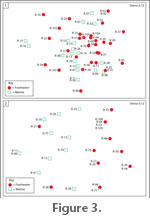|
|
|
METHODS
Outcrop is visible in five places, termed 'sections'; the Railway Cutting, Regatta Point, Regatta Tavern, Yolla Point, and Cool Store sections. Sediment samples were taken from potentially fossiliferous horizons and numbered sequentially with an "R-" prefix in the order they were collected on repeat trips over the course of five years (1991-1996). Some stratigraphic horizons were sampled several times. Samples were typically of about 500 g, except for sample R-74, which was the Nypa macrofossil sample in Pole and Macphail (1996). Several kilograms of this were collected, and about 1 kg was prepared for cuticle. Preparation of dispersed cuticle follows a standard procedure of sediment disaggregation in hydrogen peroxide and hot water followed by sieving to retain all material greater than approximately 0.5 mm maximum dimension, and remaining silicates are removed with hydrofluoric acid. At this stage the plant material is usually a hash of opaque plant fragments, and small, three-dimensional items, such as shoots of conifers, may be picked out. Final reduction of fragments to cuticle involves immersion in aqueous chromium trioxide for several hours, or heating in concentrated hydrogen peroxide. This later technique gave better results for conifer leaves, which tended to shred in the chromium trioxide. Cuticle was then washed and stained in safranin, then mounted in thymol glycerine jelly on microscope slides for transmitted light microscopy (TLM) or on aluminium stubs and either gold or (more recent years) platinum coated for scanning electron microscope (SEM) viewing. Catalogue numbers for material mounted on microscope slides is prefixed with "SB" or "SL" and SEM stubs are prefixed with "S-". Cuticle preparations of extant herbarium material cite the original herbarium sheet number ("AQ" refers to catalogue numbers of specimens in the Queensland Herbarium, Brisbane, "CANB" of specimens in the Australian National Herbarium, Canberra), and material in my own reference herbarium is prefixed with "OPH". All other material is stored in the State Herbarium of Queensland, Brisbane. The taxonomic philosophy is to place fossils in the Linnean hierarchy to the level where it is possible. This is routine with conifer and cycad fragments where epidermal details are often sufficient to either place a fossil into an extant genus, or recognise that it must be an extinct taxon. For the much more diverse angiosperms, a different approach is used; each different morphology is assigned a parataxon code consisting of the prefix "CUT-" followed by a string of letters. Nomenclaturaly these are like species without a genus, for purposes of biodiversity they can be regarded as species. For each parataxon a Reference Specimen is nominated, which is the equivalent of the holotype in Linnean taxonomy. The detailed description of each parataxon is presented in the Appendix. The taxa are presented first in taxonomic order for those cuticle parataxa that may be placed within families, and then the remainder are presented in order that they appear in a key, which groups morphologically similar taxa.
A Bray-Curtis dissimilarity was used to perform a Non Metric Multidimensional Scaling on the presence-absence data for the taxa (Figure 3). The sites were plotted in the first two axes of the analysis to represent graphically the ordination of the samples. An Analysis of Similarity was performed using the same Bray-Curtis dissimilarity matrix to determine if the factor environment (freshwater or saltwater) affected the ordination. All multivariate analyses were completed using Primer 5 version 5.2.4. |
|
